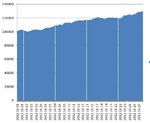15 min tlb
Senior member
- Messages
- 2,057
- Likes
- 99
Re: Price Action Trading- Video
These professors have better analytic methods and can give unbiased opinions based on objective studies .They are a reality check.
The videos posted above are advertising leads to their sites , so these videos are biased and not objective , they leave out a lot of probability information and failure rates.They are saying " we want to sell courses on this type of trading , which will make you money". The truth is far the opposite .Most of these educators are not traders just they pretend to trade . and they are telling others how to trade when they can't afford new underwear from trading profits.
Here is my return for October of 30% monthly, these pretenders (coaches) are useless traders because they CLAIM TO MAKE 30 % a year.So why should anyone listen to them?
Something to think about...
A doctorate in finance doesn't translate into being a good trader. How many of us here would listen to advice about trading from someone who has never made a trade? Would you buy an ea or a course from a marketer who is not a trader? Why then should we listen to finance professors who most likely have never taken a currency or equity trade. They may be brilliant in finance but telling others how not to trade when they aren't traders themselves is no different than the scammers telling us the same thing.
Peter
These professors have better analytic methods and can give unbiased opinions based on objective studies .They are a reality check.
The videos posted above are advertising leads to their sites , so these videos are biased and not objective , they leave out a lot of probability information and failure rates.They are saying " we want to sell courses on this type of trading , which will make you money". The truth is far the opposite .Most of these educators are not traders just they pretend to trade . and they are telling others how to trade when they can't afford new underwear from trading profits.
Here is my return for October of 30% monthly, these pretenders (coaches) are useless traders because they CLAIM TO MAKE 30 % a year.So why should anyone listen to them?

